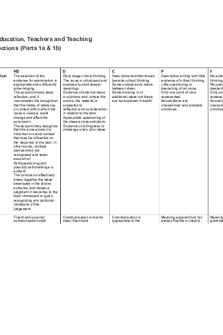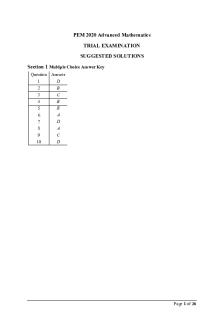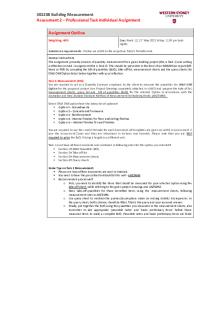Info about essay marking criteria PDF
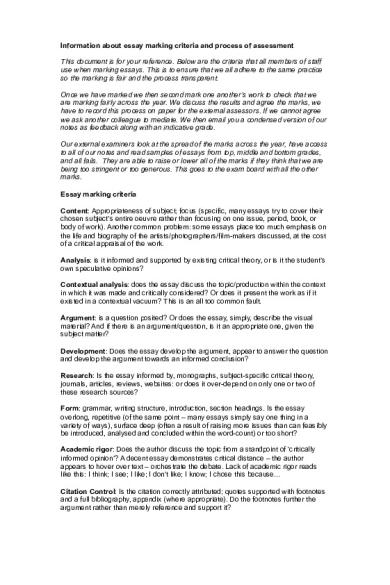
| Title | Info about essay marking criteria |
|---|---|
| Author | Zainab Irain |
| Course | Photography & Video |
| Institution | De Montfort University |
| Pages | 1 |
| File Size | 59 KB |
| File Type | |
| Total Downloads | 56 |
| Total Views | 153 |
Summary
This shows how written work is marked with the module leaders/tutors...
Description
Information about essay marking criteria and process of assessment This document is for your reference. Below are the criteria that all members of staff use when marking essays. This is to ensure that we all adhere to the same practice so the marking is fair and the process transparent. Once we have marked we then second mark one another’s work to check that we are marking fairly across the year. We discuss the results and agree the marks, we have to record this process on paper for the external assessors. If we cannot agree we ask another colleague to mediate. We then email you a condensed version of our notes as feedback along with an indicative grade. Our external examiners look at the spread of the marks across the year, have access to all of our notes and read samples of essays from top, middle and bottom grades, and all fails. They are able to raise or lower all of the marks if they think that we are being too stringent or too generous. This goes to the exam board with all the other marks. Essay marking criteria Content: Appropriateness of subject; focus (specific, many essays try to cover their chosen subject’s entire oeuvre rather than focusing on one issue, period, book, or body of work). Another common problem: some essays place too much emphasis on the life and biography of the artists/photographers/film-makers discussed, at the cost of a critical appraisal of the work. Analysis: is it informed and supported by existing critical theory, or is it the student’s own speculative opinions? Contextual analysis: does the essay discuss the topic/production within the context in which it was made and critically considered? Or does it present the work as if it existed in a contextual vacuum? This is an all too common fault. Argument: is a question posited? Or does the essay, simply, describe the visual material? And if there is an argument/question, is it an appropriate one, given the subject matter? Development: Does the essay develop the argument, appear to answer the question and develop the argument towards an informed conclusion? Research: Is the essay informed by, monographs, subject-specific critical theory, journals, articles, reviews, websites: or does it over-depend on only one or two of these research sources? Form: grammar, writing structure, introduction, section headings. Is the essay overlong, repetitive (of the same point – many essays simply say one thing in a variety of ways), surface deep (often a result of raising more issues than can feasibly be introduced, analysed and concluded within the word-count) or too short? Academic rigor: Does the author discuss the topic from a standpoint of ‘critically informed opinion’? A decent essay demonstrates critical distance – the author appears to hover over text – orchestrate the debate. Lack of academic rigor reads like this: I think; I see; I like; I don’t like; I know; I chose this because… Citation Control: Is the citation correctly attributed; quotes supported with footnotes and a full bibliography, appendix (where appropriate). Do the footnotes further the argument rather than merely reference and support it?...
Similar Free PDFs

Final Report Marking Criteria
- 1 Pages

Marking criteria - unknown drug
- 4 Pages

Essay Marking Guide
- 5 Pages

Essay-Marking Workshop
- 1 Pages

ECON 1145-Marking Criteria- May 2021
- 14 Pages

Essay Marking Guidelines
- 1 Pages
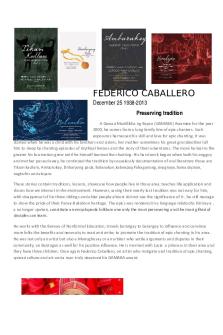
Federico Caballero info essay
- 2 Pages
Popular Institutions
- Tinajero National High School - Annex
- Politeknik Caltex Riau
- Yokohama City University
- SGT University
- University of Al-Qadisiyah
- Divine Word College of Vigan
- Techniek College Rotterdam
- Universidade de Santiago
- Universiti Teknologi MARA Cawangan Johor Kampus Pasir Gudang
- Poltekkes Kemenkes Yogyakarta
- Baguio City National High School
- Colegio san marcos
- preparatoria uno
- Centro de Bachillerato Tecnológico Industrial y de Servicios No. 107
- Dalian Maritime University
- Quang Trung Secondary School
- Colegio Tecnológico en Informática
- Corporación Regional de Educación Superior
- Grupo CEDVA
- Dar Al Uloom University
- Centro de Estudios Preuniversitarios de la Universidad Nacional de Ingeniería
- 上智大学
- Aakash International School, Nuna Majara
- San Felipe Neri Catholic School
- Kang Chiao International School - New Taipei City
- Misamis Occidental National High School
- Institución Educativa Escuela Normal Juan Ladrilleros
- Kolehiyo ng Pantukan
- Batanes State College
- Instituto Continental
- Sekolah Menengah Kejuruan Kesehatan Kaltara (Tarakan)
- Colegio de La Inmaculada Concepcion - Cebu




